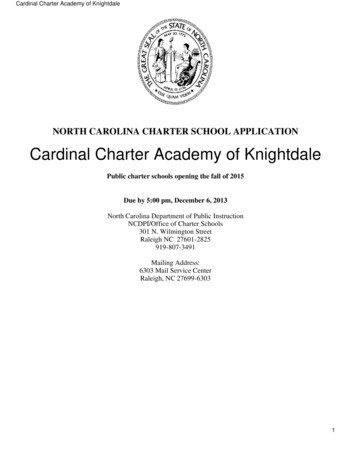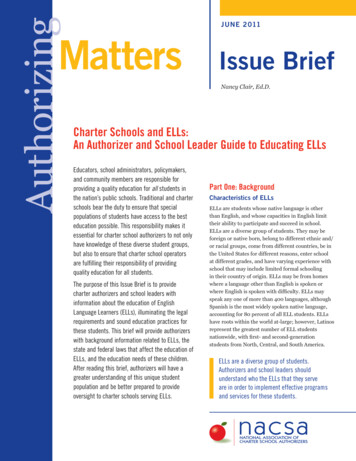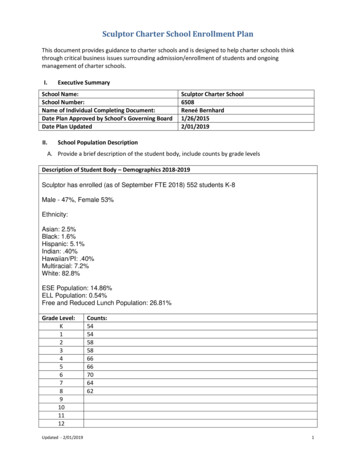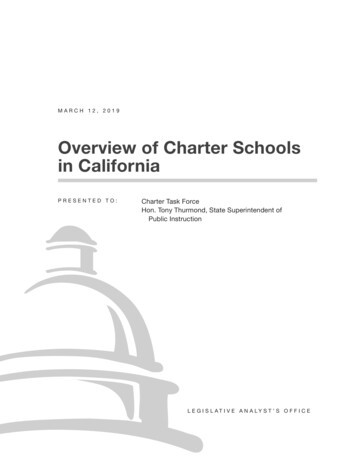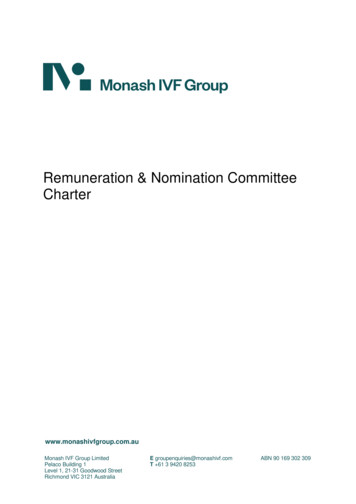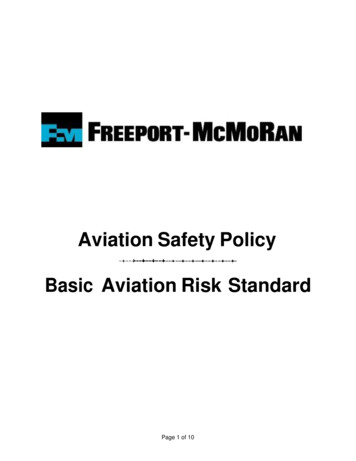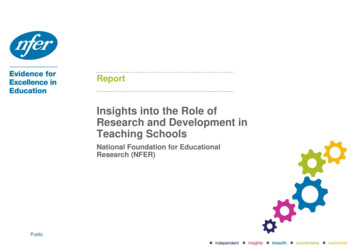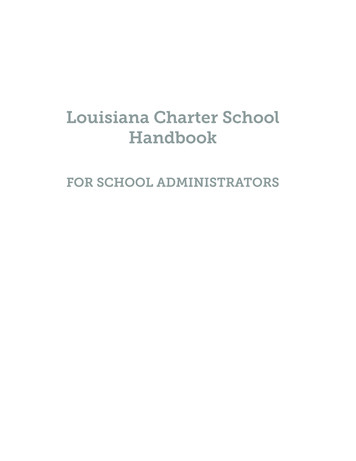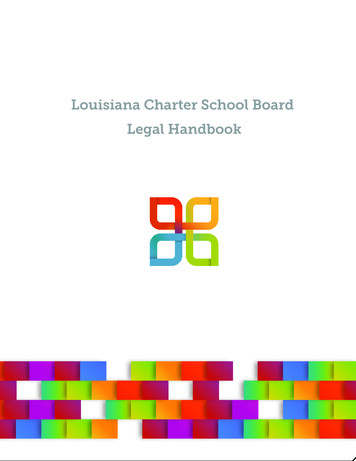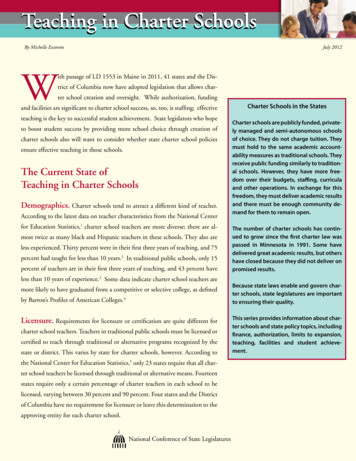
Transcription
Teaching in Charter SchoolsBy Michelle ExstromWJuly 2012ith passage of LD 1553 in Maine in 2011, 41 states and the District of Columbia now have adopted legislation that allows charter school creation and oversight. While authorization, fundingand facilities are significant to charter school success, so, too, is staffing; effectiveteaching is the key to successful student achievement. State legislators who hopeto boost student success by providing more school choice through creation ofcharter schools also will want to consider whether state charter school policiesensure effective teaching in those schools.The Current State ofTeaching in Charter SchoolsDemographics. Charter schools tend to attract a different kind of teacher.According to the latest data on teacher characteristics from the National Centerfor Education Statistics,1 charter school teachers are more diverse; there are almost twice as many black and Hispanic teachers in these schools. They also areless experienced. Thirty percent were in their first three years of teaching, and 75percent had taught for less than 10 years.2 In traditional public schools, only 15percent of teachers are in their first three years of teaching, and 43 percent haveless than 10 years of experience.3 Some data indicate charter school teachers aremore likely to have graduated from a competitive or selective college, as definedby Barron’s Profiles of American Colleges.4Licensure. Requirements for licensure or certification are quite different forcharter school teachers. Teachers in traditional public schools must be licensed orcertified to teach through traditional or alternative programs recognized by thestate or district. This varies by state for charter schools, however. According tothe National Center for Education Statistics,5 only 23 states require that all charter school teachers be licensed through traditional or alternative means. Fourteenstates require only a certain percentage of charter teachers in each school to belicensed, varying between 30 percent and 90 percent. Four states and the Districtof Columbia have no requirement for licensure or leave this determination to theapproving entity for each charter school.National Conference of State Legislatures1National Conference of State LegislaturesCharter Schools in the StatesCharter schools are publicly funded, privately managed and semi-autonomous schoolsof choice. They do not charge tuition. Theymust hold to the same academic accountability measures as traditional schools. Theyreceive public funding similarly to traditional schools. However, they have more freedom over their budgets, staffing, curriculaand other operations. In exchange for thisfreedom, they must deliver academic resultsand there must be enough community demand for them to remain open.The number of charter schools has continued to grow since the first charter law waspassed in Minnesota in 1991. Some havedelivered great academic results, but othershave closed because they did not deliver onpromised results.Because state laws enable and govern charter schools, state legislatures are importantto ensuring their quality.This series provides information about charter schools and state policy topics, includingfinance, authorization, limits to expansion,teaching, facilities and student achievement.
Charter School Teacher LicensingDCRequires licensure for charter school teachersRequires only a certain number or percentage ofcharter teachers in each school to be licensedNo statewide requirement for charter schoolteacher licensureNo charter school lawsSource: National Conferencer of State Legislatures, 2012.Turnover.Charter schools are more challenged by turn-start-ups experience significantly more teacher attrition andover than traditional public schools. High teacher attritionmobility than those that are converted from traditionalis detrimental in any school setting. It can result in instabil-public schools. Charter school teachers also may be moreity within a school and high costs to the district and state.vulnerable to leadership changes. According to the NationalRecent research by the National Center on School ChoiceCharter School Research Project, a school’s identity often isfound that the rate at which teachers leave the professiontied to its founder or leader. If the leader leaves, this mayand move between schools is significantly higher in char-create uncertainly and uneasiness among school staff.7ter schools than in traditional public schools, likely due tothe differences in teacher characteristics.6 The NationalCompensation.Center points out that charter schools tend to hire teacherswidely between charter and public schools, and charterwho are at greater risk of leaving the profession and switch-schools often do not base compensation on performance.ing schools because they are younger, less likely to have anBecause charter schools were designed to allow for moreeducation degree or state licensure, and more often workinnovation, many education experts had hoped that suchpart-time. Dissatisfaction with working conditions also con-schools would develop more creative approaches to teachertributed to turnover, since the unique environment oftencompensation. Some assert that, if fewer laws, regulationsmay not meet teacher expectations. Involuntary attrition isand union contracts bound charter school management,significantly higher in charter schools due to the lack of bar-schools could more easily create systems where teachers areriers to teacher dismissal and to a school’s possible instabil-rewarded for their skills and demonstrated effectiveness.ity. The National Center also found that new charter schoolAccording to a 2006 analysis of the Schools and Staffing2National Conference of State LegislaturesTeacher compensation does not vary
Survey, charter schools are significantly more likely to paybargaining agreements and exempt new start-ups or thosehigher salaries for a particular skill or qualification, includ-sponsored by another management organization. Othering teaching in hard-to-staff schools and subjects and hold-states—including Alaska, Connecticut and Maryland—ing National Board for Professional Teaching Standards cer-hold charter schools to existing agreements, but allow ad-tification.ditional school-specific negotiation.8Two-thirds still report teacher pay is similar tothat of traditional public schools, where salaries are basedon a system that rewards only for years of service and levelThe ability of teachers in a particular school to organize andof education. The National Charter School Research Projectcollectively bargain also may depend on whether the teach-argues that charter schools can and should develop a moreers technically are employees of the school or of the chartercreative approach to compensation.9management organization. In a 2005 decision regarding labor relations in California charter schools, for example, aCollective Bargaining.Collective bargaining rightsregional director of the Public Employment Relations Boarddiffer for charter school teachers. Such rights for teachersruled that the appropriate unit of teachers, for purposes ofcan be a determining factor in support for or oppositionan election to organize under the Educational Employmentto charter schools. These schools often are not unionized,Relations Act, includes all the teachers employed by theand teachers do not collectively bargain for their salary andcharter management organization across all its school sites.benefits. On one hand, this frees charter school management to make decisions about compensation and staffingthat benefit the individual school and unique students. Thiscan, however, leave charter school teachers vulnerable to un-State Policies that SupportEffective Charter School Teachingfair employment practices and without a collective teachingter Schools, 20 states and the District of Columbia exemptPreparation, Recruitment and ProfessionalDevelopment. Charter schools are, by definition,charter schools from collective bargaining agreements, andunique and may look very different from traditional pub-only Iowa holds all charter schools to all existing school dis-lic schools. They may use different curriculum, incorporatetrict collective bargaining agreements. The remaining 20the latest digital technology, and even structure their staffingstates with charter schools fall somewhere between the twoand daily schedules to meet their unique needs. Teachersextremes.10who come from traditional preparation programs often arevoice. According to the National Alliance for Public Char-not prepared to teach in this environment and often do notHawaii, for example, holds charters to existing agreements,envision this career path. A 2010 study by the Nationalbut allows modification if the exclusive union representa-Center on School Choice found that few teacher applicantstives and the local charter school board enter into supple-equally considered teaching in a charter school and a tra-mental agreements that contain cost and non-cost items toditional public school. In fact, most completely avoidedfacilitate decentralized decision making. Some states holdapplying to charter schools or did so only as a last resortnew charter schools that are sponsored by the school districtbecause they were unfamiliar with or unclear or confusedor converted from existing schools to the district’s collectiveabout charter school structure and atmosphere.11 One pol-3National Conference of State Legislatures
icy approach is to create an on-site, recruiting, training andteachers to unionize, and is the only one in California toprofessional development program so charter schools cando so. Green Dot boasts lower than average turnover rates,educate and support teachers to meet their unique needs.and teachers report high levels of job satisfaction and goodThis allows schools to develop aspiring teachers for a rangeworking conditions. All Green Dot teachers pay union duesof career options, including teaching, leadership and admin-to the California Teachers Association and the Nationalistrative positions.Education Association. The collective bargaining agreementcontains only a few centralized policies—salary, health care,The National Resource Center on Charter School Financeclass size and number of work days. The following are keyand Governance recently profiled the Teacher Intern Pro-aspects of the contract.gram and the Graduate School of Education of High TechHigh, a charter school management organization in San Teachers are given explicit decision-making authorityDiego, Calif. This promising program allows teachers toin setting school policy, including the school’s budget,earn their credentials while they also earn a salary and arecalendar and curriculum.trained in High Tech High’s core design principles and educational vision. This program is proving successful. In its period for new teachers, and all teachers work under thefirst graduating class in 2007, 60 percent of graduates wereprotection of “just cause discipline and dismissal.”credentialed in math and science, which typically see severeshortages of qualified teachers. For the 2007-2008 school year, more than 2,000 applicants applied for only 51 positions, and its teacher workforce is more diverse than that ofsurrounding schools.12There is no tenure, seniority preference or probationaryTeachers work “a professional work day” rather than defined minutes. Flexibility is afforded to adjust the contract in criticalareas over time; the contract is renegotiated every threeCollective Bargaining and Compensation.Some states allow charter school teachers to unionize soyears by Green Dot management and the local unionand ratified annually by the teachers’ union.13they can bargain for salary, benefits and working condi-States also can remove barriers, including collective bargain-tions; however, they are not held to the same agreement asing requirements tied to the district, so charter schools canall schools within the district. This approach allows bothbetter design compensation structures to recruit and retainteachers and management to arrive at agreements that hon-the teachers that fit their school vision. The schools canor and recognize the individuality and unique attributes ofmore creatively provide incentives and reward teachers whothe school, yet still provide teachers with a collective voicemeet the school’s student achievement goals and their indi-and representation.vidual improvement plans, instead of being tied to a modelthat links compensation to years of service and educationalA successful model is Green Dot Public Schools in Losattainment.Angeles, Calif. Green Dot is one of a few nondistrict public school operators in the United States that has allowed4National Conference of State Legislatures
Policy Questions to Consider Do traditional and alternative preparation programs and professional development providers in your state prepareand support teachers to teach in alternative settings, including charter schools? Do charter school teachers in your state report in surveys or research that they feel adequately prepared for andsupported in their positions? Does your state require licensure or certification for charter school teachers? If not, how do you ensure that charterschool teachers are adequately prepared and monitored for performance and discipline? Does your state require charter schools to abide by existing collective bargaining agreements? Does your state allowcharter schools to individually bargain collectively with its teachers? Do your state policies allow charter schools to create alternative compensation and benefit models to use compensation as a tool to recruit, retain and reward effective teaching? Do your state policies allow charter school teachers to acquire tenure or a long-term employment agreement? Inyour state, has this helped or hindered a charter school’s ability to make hiring decisions that are in the best interestsof students?This publication was generously funded by the Walton Family Foundation. NCSL is grateful to the foundation for supporting this project and recognizing the importance of state legislatures in ensuring high-quality charter schools.Michelle Exstrom wrote this brief. Completion of this brief was made possible with the guidance of NCSL’s EducationProgram director, Julie Davis Bell, and input from NCSL’s charter school expert, Josh Cunningham. Leann Stelzer editedand designed the brief.5National Conference of State Legislatures
Notes1. National Center on Education Statistics, 2011 Digest of EducationStatistics (Washington, D.C.: NCES, 2011), Table 106, http://nces.ed.gov/programs/digest/d11/tables/dt11 106.asp.2. Ibid.3. Ibid.4. Marisa Burian-Fitzgerald, Michael T. Luekens, and Gregory A.Strizek, “Less Red Tape or More Green Teachers: Charter School Autonomy and Teacher Qualifications,” in Taking Account of Charter Schools:What’s Happened and What’s Next? ed. Katrina E. Bulkley and PriscillaWohlstetter (New York: Teachers College Press, 2003); Caroline M.Hoxby, “Would School Choice Change the Teach Profession?” Journalof Human Resources 37, no. 4 (2002): 846-891; and Bruce D. Baker andJill L. Dickerson, “Charter Schools, Teacher Labor Market Derregulation,and Teacher Quality: Evidence from the Schools and Staffing Survey,”Education Policy 20, no. 5 (2006): 752-778.5. National Center on Education Statistics, 2011 Digest of EducationStatistics.6. D. Stuit and T. Smith, Research Brief: Teacher Turnover in Charter Schools (Nashville, Tenn.: National Center on School Choice, June2010).7. National Charter School Research Project at the Center for Reinventing Public Education, You’re Leaving? Succession and Sustainability inCharter Schools (Seattle: National Charter School Research Project at theCenter for Reinventing Public Education, December 2010).8. Michael Podgursky, “Teams Versus Bureaucracies: PersonnelPolicy, Wage-Setting, and Teacher Quality in Traditional Public, Charter, and Private Schools,” paper presented at the National Conferenceon Charter School Research, Vanderbilt University, National Center onSchool Choice, Nashville, Tenn., 2006.9. Michael DeArmond, Betheny Gross, and Dan Goldhaber, “LookFamiliar? Charters and Teachers,” in Hopes, Fears, & Reality: A BalancedLook at American Charter Schools in 2007, ed. Robin J. Lake (Seattle:National Charter School Research Project, December 2007).10. National Alliance for Public Charter Schools, Measuring Up tothe Model: A Ranking of State Charter School Laws (Washington, D.C.:NAPCS, January 2011), px?comp 17.11. Marisa Cannata, Research Brief: Charter Schools and the TeacherJob Search (Nashville, Tenn.: National Center on School Choice, July2010), 2.12. National Resource Center on Charter School Finance and Governance, Implementing an In-House Approach to Teacher Training andProfessional Development (Washington, D.C.: National Resource Centeron Charter School Finance and Governance, n.d.), ter-schools/publications/other/An InHouse Approach to Teacher Training HighTechHigh.pdf.13. National Resource Center on Charter School Finance and Governance, Empowering Teachers through a CMO-Created Union (Washington, D.C.: National Resource Center on Charter School Finance andGovernance, n.d.), ter-schools/publications/other/Empowering Teachers through aCMO-Created Union.pdf.National Conference of State LegislaturesWilliam T. Pound, Executive Director7700 East First PlaceDenver, Colorado 80230(303) 364-7700444 North Capitol Street, N.W., #515Washington, D.C. 20001(202) 624-5400www.ncsl.org 2012 by the National Conference of State Legislatures. All rights reserved.ISBN 978-1-58024-670-56National Conference of State Legislatures
3 National Conference of State Legislatures Survey, charter schools are significantly more likely to pay higher salaries for a particular skill or qualification, includ-ing teaching in hard-to-staff schools and subjects and hold-ing National Board for Professional Teaching Standards cer-tification.8 Two-thirds still report teacher pay is similar to
